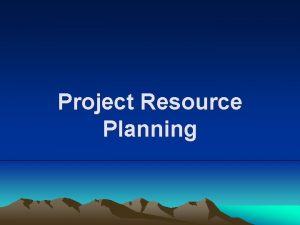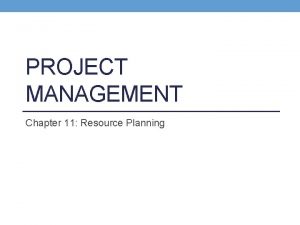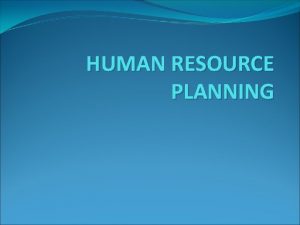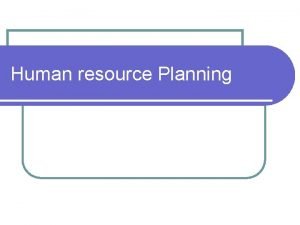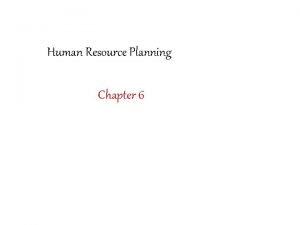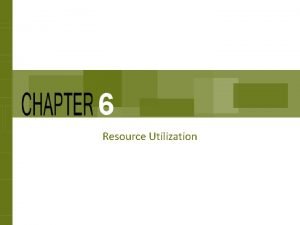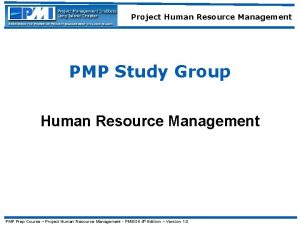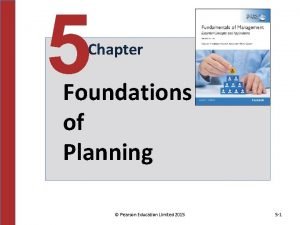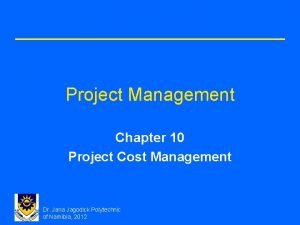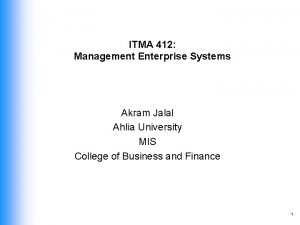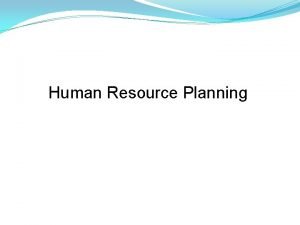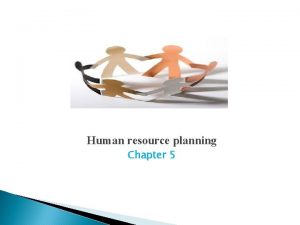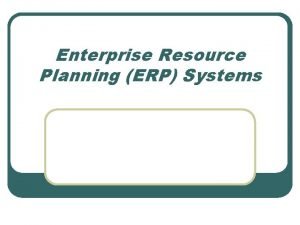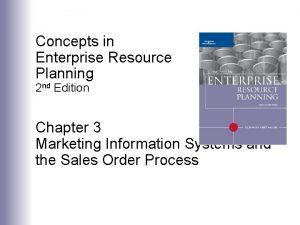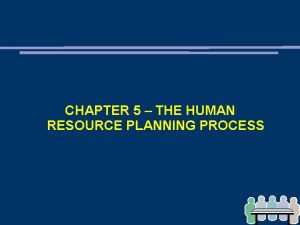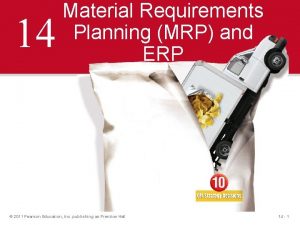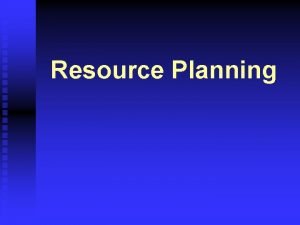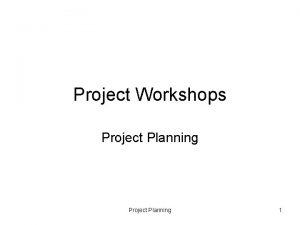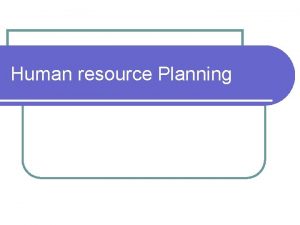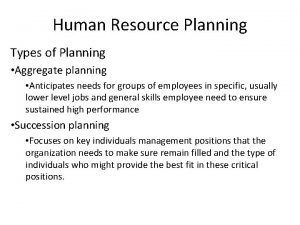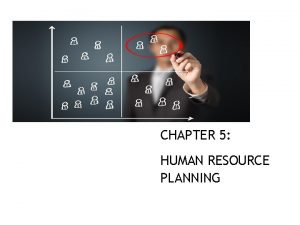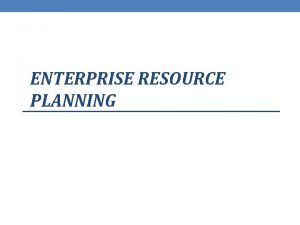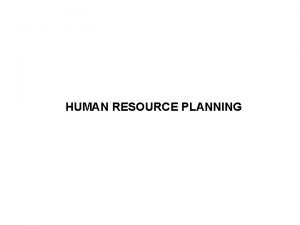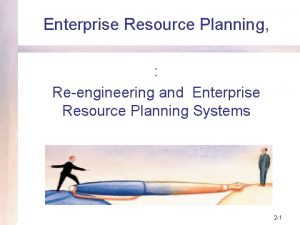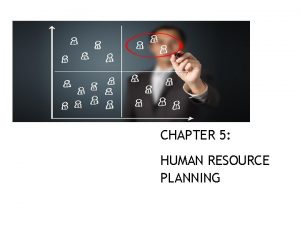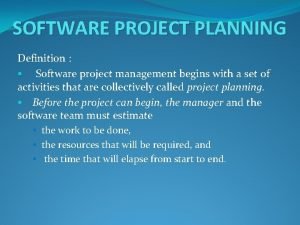Project Resource Planning Resource Definition A resource may



























- Slides: 27

Project Resource Planning

Resource Definition • A resource may be defined as the machine or person who will perform the scope of work. • Resource planning is forecasting the resources required to perform the scope of work within the time plan. • The resource constraint should be considered after the network diagram, schedule bar chart and procurement schedule have been developed.

1. Resource Estimating • The resource estimate is linked directly to the scope of work and bill of materials (BOM). • The scope of work may be expressed as so many tones of steel, or so many square meters of wall to be painted etc. From this description the estimator can convert the scope of work into man hours per unit "X".

1. Resource Estimating • The next step is to consider the direct trade off between the resource requirement and the activity's duration. • Consider the following, if the scope of work is to erect 12 tones of steel and the estimator knows from past experience that the work can be done in 150 man hours per tone and the men work 10 hour shifts, then the equation is:

1. Resource Estimating • The resource / duration trade off would then be as follows: • By varying the resource availability, the duration of the activity will change.

2. Resource Forecasting • The next step is to forecast the total resource requirement by discipline or interchangeable resource. • This is done by compiling all the resource estimates and presenting them in a structured resource table.

2. Resource Forecasting

3. Resource Availability • The next step is to quantify the resources available inside and outside the company. • The following points should be considered: Ø Other resource commitments if your company is involved in a number of projects which all draw from a common labor pool, the other projects' requirements must also be considered.

3. Resource Availability • The following points should be considered: Ø The anticipated sickness and absenteeism rate – Example: allow for a 25% absentee rate based on your past time sheets

3. Resource Availability • Keeping the above points in mind, the resource availability table will be developed. • Consider the following example :

4. Resource Histogram • The resource histogram is a popular planning tool because it gives a good visual presentation which is easy to assimilate and understand. • The prerequisites for drawing the resource histogram are: Early start barchart (after considering the procurement requirements) Resource forecast per activity

4. Resource Histogram • Consider the following example: Resource Table

4. Resource Histogram • Barchart and Resource Histogram

5. Resource Loading • The resource forecast is now compared with the resources available. The ideal situation is achieved when the resource requirement equals the resources available. • Unfortunately, in project management this seldom happens, because it is not always possible to adjust supply with demand, so some form of compromise is essential.

5. Resource Loading • A resource overload is when the resource forecast exceeds the available resources, while a resource underload is when resource forecast is lower than the available resource. • A resource overload will lead to some activities being delayed which could delay the completion of the project. • a resource underload will under utilize the company's resources which could have a detrimental effect on the company's profitability.

5. Resource Loading

5. Resource Loading • The overloads and underloads can now be identified and addressed as follows: Resource Smoothing: assign resources to critical activities first, then try moving the other activities to ease any overload and under utilization. Time Limited Resource Scheduling: the end date of the project is fixed, so resources must be increased to address any overloads. Resource Limited Resource Scheduling: the maximum number of resources is fixed, so the end date may need to be extended to address any overload. Increase Resources: to address an overload. Reduce Resources: to address an underload (underutilized).

6. Resource Smoothing • Resource smoothing is the process of moving activities to improve the resource loading profile. The first step is to select the resource to be smoothed. To decide which resource to smooth consider: The resource that is most overloaded. The resource that is most used on the project. The least flexible resource this could be the resource that comes from overseas, is difficult to get hold of or is least available. The most expensive resource to hire.

6. Resource Smoothing • Resource smoothing Example

6. Resource Smoothing • Barchart and Histogram

6. Resource Smoothing • Smoothed Barchart and Histogram

7. Time Limited Resource Scheduling Ø Time limited resource scheduling is used when the end date of the project cannot be exceeded. In which case any resource overloads will have to be addressed by increasing the resources when they are required Ø This situation could occur when: The project has heavy time penalties. Building a new hotel to meet the summer season. Opening of the Olympic Games.

7. Time Limited Resource Scheduling Once the end date of the project and milestones have been contractually agreed, time limited scheduling will become a powerful tool to assist the planner to achieve these commitments.

8. Resource Limited Resource Scheduling Ø Resource limited resource scheduling is when there is a resource limit which cannot be exceeded; if there any resource overloads then some planned activities will have to be delayed. If this process delays any critical activities, then the end date of the project will be extended.

8. Resource Limited Resource Scheduling Ø This situation could occur when: A confined space ﻣﻜﺎﻥ ﺿﻴﻖ will limit the number of people able to work there. Where there are limited facilities. Where there are equipment limitations, e. g. the number of computers, machines, drawing boards, lifts or scaffolding ﺳﻘﺎﻟﺔ. Safety requirements may limit the number of workers in a certain area.

9. How to Increase Resources? Ø When the resources are overloaded there a number of options to increase the resources available: Working Overtime Working Shifts Increase Productivity Learning Curve Sub Contractors Scope of Work

10. Reduce Resources Ø When the resources are underloaded, or there a number of options for reducing the available resources: Move unemployed resources to critical activities. Pre manufacture to make components before they are needed. Maintenance of equipment during slack periods. Train your workforce during slack periods to gain new skills.
 Resource planning definition
Resource planning definition Resource planning definition in project management
Resource planning definition in project management Definition of hrp
Definition of hrp Hr planning meaning
Hr planning meaning What is human resource planning definition
What is human resource planning definition Human resource forecasting definition
Human resource forecasting definition A c f h k
A c f h k Project management human resources
Project management human resources Hci design patterns
Hci design patterns Formal planning may create rigidity.
Formal planning may create rigidity. Foundations of planning
Foundations of planning Resource allocation vs resource leveling
Resource allocation vs resource leveling Perbedaan resource loading dan resource leveling
Perbedaan resource loading dan resource leveling Why is forecasting important in human resource planning
Why is forecasting important in human resource planning Resource aggregation in project management
Resource aggregation in project management Enterprise resource planning example
Enterprise resource planning example Short term and long term human resource planning
Short term and long term human resource planning Meaning of human resource planning
Meaning of human resource planning 5 stages of human resource planning
5 stages of human resource planning Human resource management question paper
Human resource management question paper Factors affecting human resource management
Factors affecting human resource management Enterprise resource planning overview
Enterprise resource planning overview Enterprise resourse planning systems
Enterprise resourse planning systems Enterprise resourse planning
Enterprise resourse planning Forecasting techniques in human resource planning
Forecasting techniques in human resource planning Cayenta workflow management
Cayenta workflow management Material requirements planning
Material requirements planning Enterprise resource planning tradução
Enterprise resource planning tradução
